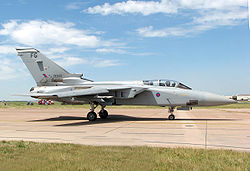UK fighters confront Russian bombers over international waters
Sunday, May 13, 2007

Last week, RAF Leuchars in Fife scambled two Tornado F3 interceptors, when radar detected two Tupolev Tu-142 Bear Bombers and the alarm was sounded "Bears in the Air".
The RAF would not disclose the exact time of the incident, which was to the north of the Outer Hebrides. It did say that no contact was made between the aircraft.
The Russian Bear Foxtrot bombers are renowned maritime raiders that regularly probed the United Kingdom's airspace during the Cold War.
The Russian aircraft were snooping on Neptune Warrior, a Royal Navy exercise taking place near the Outer Hebrides last week. Neptune Warrior was a live-fire naval training exercise involving warships, submarines and aircraft that took place between April 22 and May 3.
| “ | The Russians obviously thought it might be worth coming to have a look at what we were up to and probably take some photos. It's a throwback to the Cold War when they used to fly in regularly to poke and prod at the edges of British airspace and test our reaction times. It's normal to let such aircraft know we're there by pulling up alongside them and they left quietly. The whole encounter probably lasted 20 minutes. | ” |
— Keith Wardlaw, Sqn Leader
|
The Tornado's watched the Russians for approximately 15 minutes until the bombers returned to their home base in Murmansk.
| “ | This aircraft dates back to the 1950s and although the air frame might look dated it is still highly effective in terms of long-range maritime reconnaissance. These used to fly over the North Sea and the Greenland Gap daily during the Cold War and, while rare today, it's by no means a unique occurrence. It's nice to know the Russians are out and about again. The exercise was in international waters and the Russians have got just as much right to be there as we have. We do it to them, they do it to us. All the RAF is doing is telling them: We could do this for real if we wanted to, so go and tell your mates back home.' | ” |
— Paul Jackson, editor of Jane's All The World's Aircraft
|
During the Cold War in the 1970s and 1980s, Soviet spies were sometimes spotted watching from the perimeter of RAF stations to time exactly how long it took jets to take off and intercept Bear bombers, probing the United Kingdom's defences and testing the response. Nato pilots in those days were well accustomed to an almost daily aerial game of cat-and-mouse.
Squadrons of Phantom interceptors were on constant quick-reaction standby through the 1970s and 1980s to deal with the threat of Soviet long-range bombers engaging in a long-range attack on Great Britain. The Bears can carry an arsenal of missiles, some nuclear-tipped, to strike NATO warships blocking the entrance to the vital North Atlantic sealanes between the United States and Europe.
In July, the Tornado will be replaced by the new Eurofighter Typhoon. Currently, RAF personnel on scrambling duty spend most of their time on counter-terrorist missions, checking out commercial airliners approaching Britain in ways that arouse suspicion, either because they have taken the wrong flight path or because the pilot has not contacted ground control.
Sources
edit- Ian Bruce. "RAF fighters scrambled to meet Russian jets over Navy exercise" — The Herald (Glasgow), May 13, 2007
- "Cold War reheated - RAF Tornados foil Russian spy in sky" — This Is London, May 13, 2007
- "RAF jets see off Russian spy planes" — The Daily Telegraph, May 12, 2007
- Jude Sheerin. "Red Alert" — The Daily Record, May 10, 2007
- "Russian spy planes emerge warning on Moscow’s unclear long-term ambitions" — Global Challenges Research, May 10, 2007
- Michael Evans. "Russian ‘spy’ planes put RAF on Cold War alert" — Times Online, May 10, 2007
- "RAF jets intercept Russian planes" — BBC, May 10, 2007
- Matthew Hickley. "Cold War reheated - RAF Tornados foil Russian spy in sky" — Daily Mail, May 10, 2007
- Press Release: "Operation Neptune - Live Fire Brief" — Joint Maritime Operation Training Staff, March 29, 2007